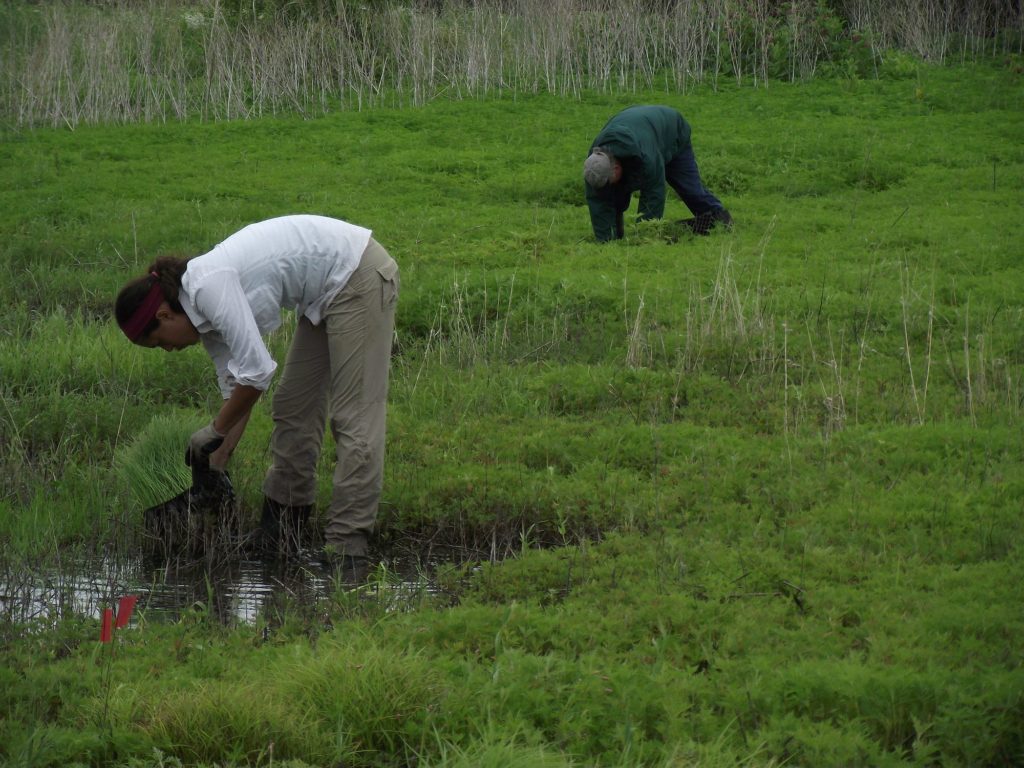
What’s not to like? Sunk ankle-deep in mud. Fighting mosquitoes the size of small aircraft. Bent over for a couple of hours planting hundreds of tiny seedlings. All while surrounded by the largest crop of ragweed you’re likely ever to see in your life? Oh, and did I mention free pizza? That’s a good time, my friends. That’s recovering the health of a premier wet prairie at Midewin.
Earlier this year, miles of drain tile were removed from a 460-acre parcel known as Grant Creek, which had kept the pastureland drier and more productive for raising cattle. Now, fueled by a pretty wet spring and early summer, water once again is pooling on the surface of the earth. Just as it did prior to settlement more than 150 years ago.

It’s into these wet areas we venture, with rubber boots and rubber gloves. To plant some 70 different species of wetland-loving plants. We work in pairs, one person to dig the hole with an auger, the other to place in the hole a tiny seedling.

Volunteers and staff work side by side. Rolling up his sleeves, Paul Botts, executive director of The Wetlands Initiative, teams up with Midewin ecologist Bill Glass. I set to work with Jeff, who oversees brush removal at Midewin, on flats of winged liatris and some kind of sedge. Dig a hole. Pop a plant plug into it. Backfill, making sure the crown of the plant is just below the surface. Repeat.
In spite of the monster-sized mosquitoes, it’s a perfect day to be in the field. Last year, during Phase I planting, we sweltered under full sun, high temps and humidity. This year, it’s cool and overcast. A long-sleeved shirt and a little bug spray keep the worst of the skeeters at bay. Rubber boots keep our feet dry. And the rampant ragweed is nowhere near to blooming, so there’s no immediate threat of allergic reaction.

But this is how it’s done. This is how you return a pasture with a handful of weedy plant species back to a functioning wet prairie, with more than 100 species of plants, and untold species of related insects, herps and birds. Even at this early stage of restoration, the bobolinks and other grassland birds are nearly thick as flies. We even found a dickcissel nest sporting a clutch of sky-blue eggs.
When it’s lunchtime, Jerry Heinrich, president of the Midewin Alliance, provides the two dozen volunteers and staff of both the US Forest Service and The Wetlands Initiative, with free pizza. Delivered to our wetland. That’s service.
And after lunch, I take a walk with TWI’s Senior Ecologist, Gary Sullivan, through the Phase I area planted last year. He points out some of the early colonizer plants that have established themselves. Black-eyed Susans. Ohio Spiderwort. And many other native forbs.
All these beautiful wildflowers amid a rage of annual farm weeds, which still must be controlled. Probably by mowing. Including the ragweed before it blossoms and sets seed. But this is all part of the process. In time, with proper management, the perennial native plants will be strong and numerous enough to out-compete the annual non-native weeds, and the wet prairie will be well on its way to nature haven.
